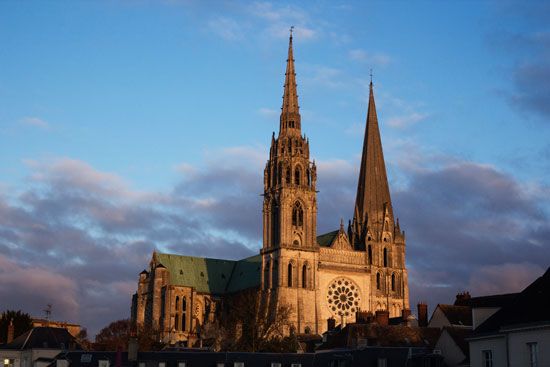Chartres
Our editors will review what you’ve submitted and determine whether to revise the article.
Chartres, town, capital of Eure-et-Loir département, Centre région, northwestern France, southwest of Paris. The town is built on the left bank of the Eure River, and the spires of its famous cathedral are a landmark on the plain of Beauce. Wide boulevards, bordered by elms, encircle the old town with its steep narrow streets that lead down to picturesque houses by the river. The modern city has seen much recent growth in the neighboring plain, which is an important route between Paris and the Loire valley, and toward Brittany.
The main part of the great cathedral of Notre-Dame at Chartres was built in less than 30 years in the mid-13th century, when High Gothic architecture was at its purest. This gives it a unity that is almost unique. The cathedral was built to replace a 12th-century church of which only the crypt, the base of the towers, and the west facade remain. Remarkable 13th-century stained glass windows and a Renaissance choir screen add to the beauty of the edifice. Another notable church is Saint-Pierre, built mainly in the 13th century. A museum is housed in the former Episcopal Palace, dating from the 17th and 18th centuries.
Chartres, named for a Celtic tribe, the Carnutes, who made it their principal Druidic center, was attacked several times by the Normans and was burned by them in 858. In the Middle Ages it became a countship and was held by the families of Blois and Champagne. The city was sold to the king of France in 1286, but during the Hundred Years’ War (1337–1453), the English occupied it for 15 years. Francis I raised it to the rank of a duchy in 1528. During the Wars of Religion, the Protestants attacked it unsuccessfully. Henry IV was crowned there in 1594. During World War II, the town was severely damaged.
Chartres is an administrative and commercial center which also serves the surrounding Beauce cereal-producing region. The town is important for both its cultural and tourist activities. Modern industries include cosmetics, electronic equipment, and automobile components. The proximity of Paris has stimulated its development. Pop. (1999) city, 40,361; urban area, 130,681; (2014 est.) city, 38,728.















